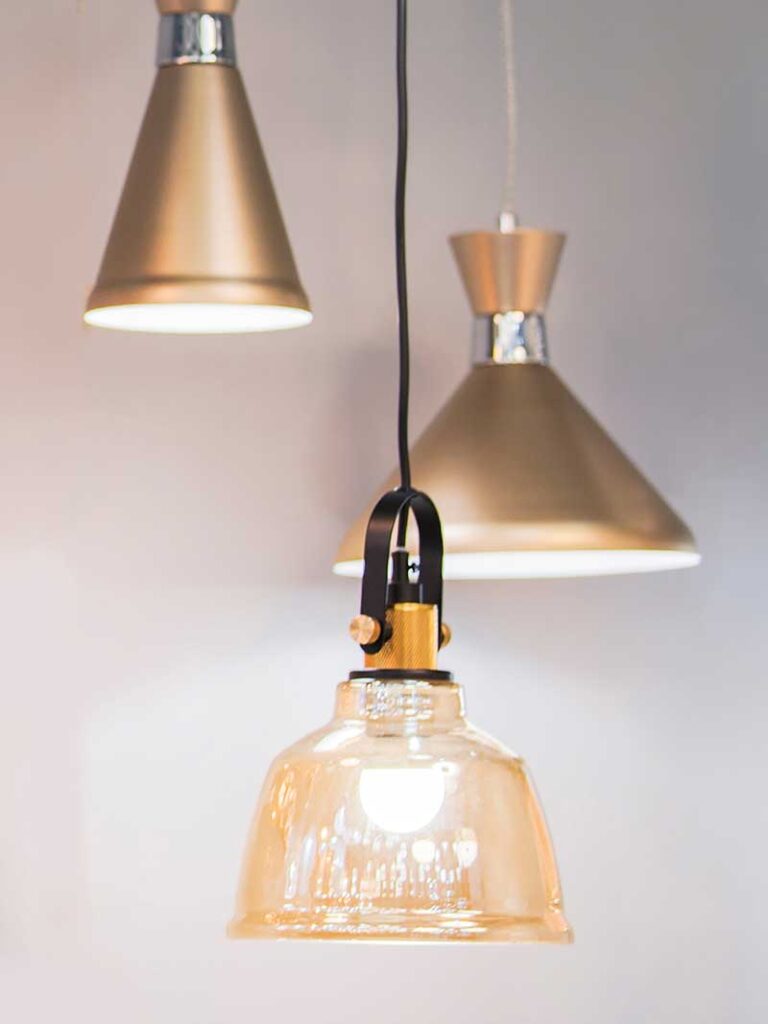
Would highly recommend.
Quick response and good workmanship
Thanks
Special thanks, also, to Steve's earnest contribution: not only for his positive and courteous attitude but also the due diligence and care consistently applied in terms of cleaning up after each stage in the whole process. Much admired and greatly appreciated.
Overall, I am very pleased with the entire experience and, as such, would happily recommend TM Hughes and Son to others.
Welcome to TM Hughes & Son Electrical Services Ltd. We offer Lighting design and installation in Essex to residents and businesses.
We have NICEIC-registered Electricians available for all lighting jobs, big and small, including installation, upgrades and repairs.
Call – 01245 830560
Lighting Services Include
- Indoor Lighting
- Exterior Lighting
- Security Lighting
- Free Quotes
- Emergency Call Outs
- No Call-Out Charges
Domestic Lighting
Professionally fitted Lighting can significantly enhance your standard of living by improving your Essex home’s look and ease of use indoors and outdoors.
We offer Lighting that is expertly fitted to your unique requirements. An electrician can visit your home to discuss your needs and wants and design a customised lighting system. You may not want a brand-new lighting installation.
You may already have some lights you wish to have fitted to work with your existing lighting installation. We’ll happily fit them for you. An electrician will recommend bulbs, colour and strength to get the most out of your lights.
We also offer the full range of outdoor Lighting that’ll enhance the look of your home, provide Lighting in outdoor living areas and provide security.
Commercial Lighting
We design, install, and repair lighting installations for Essex businesses. We cover all types of companies of all sizes, from small retail units to large factories and offices.
Commercial Lighting has come on in leaps and bounds over the past few years with the advent of energy-efficient LED lighting. New installations are better for health and safety and employee productivity, and they cost a lot less to run, saving many units of energy and sums of money.
We also fit security lighting, which is essential for protecting your premises. Commercial lighting design and installation starts with a visit from one of our experienced electricians.
An electrician will visit your premises, review your requirements and answer all your questions and concerns. The electrician will write you a free, no-obligation quote.
We can plan installations around your working/production hours, so there’s little disruption to your business’s day-to-day running while work is being carried out.
Planning Lighting Installations
Lighting installations are properly planned from the start. Whether the installation stands alone or has to work in conjunction with building/renovation work, a stringent planning procedure is followed.
If you’re undergoing any building or landscape work, our Electricians are used to working with site managers, architects, builders and landscape gardeners. Lighting should be planned at the beginning before any building/refurbishment work commences.
If you only require new Lighting, installations are designed to meet your requirements and work with your existing space.
Lighting & Building Regulations
Lighting installations undertaken on domestic and commercial properties must be done and signed off by qualified electricians. All work undertaken by TM Hughes & Son involves NICEIC-registered electricians with many years of experience. All installations will adhere to the current required building regulations. The necessary certification accompanies all work.
Lighting Design & Installation Considerations
When designing your lighting installation, we first discuss what you like regarding light design, switches, bulb colour, etc. If you’re unsure what you want, one of our electricians will present some options so you can pick the lights and fittings you like. We will consider the following once we have a good idea of what you want:
Room Size
Each room is measured in every direction. The square footage of each room is calculated along with length, width and height. By establishing the size, we can accurately calculate the bulbs and power required to light the room optimally.
Room Use
The use of the room will determine the wattage of bulbs; some rooms need more light than others. Hallways require the least amount of bulb power. They are merely walked through and usually have good natural light. Bathrooms need considerably more light, natural light is generally reduced, and tasks that need lots of light (such as grooming) are done in the bathroom. Kitchens usually need more lights but less power than bathrooms. Living areas need lower-powered relaxing lights.
Times Of Room Use
The time of day each room is used is another consideration. Times vary from household to household and are another factor we use to calculate the best bulb wattages.
Occupant Age
Are you a young professional living alone? A family with children? or an elderly couple? All have different lighting requirements. As a general rule of thumb, the older one gets, the more light is needed.
Windows
Most rooms have windows, and all windows let in natural light. Natural light varies depending on the size and direction of the window. South-facing windows let in much natural light, while north-facing windows let in considerably less. East & West facing windows sit somewhere in the middle. Where possible, lighting installations are designed to work with natural light, but rooms occupied mainly during the day with heavy natural light need little Lighting. Lights are generally kept away from windows.
Enhanced Features
Homes have architectural features such as arches, feature walls, vaulted ceilings and fireplaces. Attractive features can be enhanced with Lighting so they stand out more.
Hide Features
It pays to keep light away from some features, such as radiators and central heating controls, which most don’t want to stand out unless you have designer radiators and controls which work with your decor.
Furniture Position
Furniture position helps determine the lighting position. Seating and dining areas are best served by overhead Lighting, for example.
Light Switches Function & Position
With new lighting installations, we work out the most convenient place for each light switch. If you’re upgrading your current Lighting, we can reposition switches to a better location. Switches include 1-, 2-, and 3-way dimmers and the latest smart switches.
Lights
Various types of lights are used for different purposes in the home and commercial setting. Their function is to choose lights and positioning. Additional lights can be combined to produce stunning lighting effects in certain areas. Each homeroom will require different lights and bulbs of different wattages.
Ambient Lights
Ambient lights are the most common light used in the home. The ambient light’s job is to illuminate the room to be seen in low and dark light levels. Ambient lights include downlights, uplights and directional Lighting. Downlights are attached to the ceiling and illuminate downwards. Uplights are attached to walls and bounce light off the ceiling, generally softer than downlights. Directional Lighting can be attached to ceilings and walls. Lights are pointed in a specific direction.
Accent Lights
Decorative lights are used to create impressive looks or enhance the features of your home.
Task Lights
Task lights assist with everyday tasks such as cooking, grooming, making up applications, and reading.
Outdoor Lights
Outdoor lights illuminate areas for comfort, safety, security and decorative reasons.
Types Of Interior Light
Types of interior lights include:
Arm
Arm lights are fitted to the wall and feature one (one bulb) or two (two bulbs) arms. The arms can be fixed or adjustable depending on the design. Arm lights can work as ambient, task and decorative Lighting.
Chandeliers
Chandeliers are usually bright and bold, constructed from glass and metal. The look itself adds a decorative element to each room. Chandeliers typically have multiple bulbs, with the most common being candle bulbs.
Flush & Semi-Flush
Flush lights sit tight to the ceiling, perfect for bathrooms, as the design keeps water and moisture away. Semi-flush lights sit close to the ceiling but with a few inches of hang. Both designs work well for lower ceilings. Wall flush lights are also available.
Pendants
The standard domestic light hangs from the ceiling with a cable. Pendant lights are available as classic ceiling roses (which usually include a lampshade). Many designer versions are available to suit every taste imaginable. Depending on the design, pendants have one, two or multiple bulbs.
Recessed
Recessed lights are fitted inside the ceiling and are usually fitted in multiples.
Track
Track lights are fitted to an adjustable track so the lights can be moved and pointed in various directions.
Strip Lights
Illuminate pictures, mirrors or photos, a type of ambient or task light.
Up & Down
A wall light that shines in both directions, illuminating the room via the ceiling and the wall, provides a nice decorative effect.
Uplighters
Uplighters shine upwards towards the ceiling; the lights reflect, illuminating the room softly.
Light Bulbs
Light bulbs are available in many different types; the correct choice is vital and will make or break your Lighting. Our planning procedure (see above) allows us to select the best bulb for any situation. Bulbs vary in wattage, size, colour, shape and fitting type.
Here are the different types of light bulbs available
CFL
Compact Fluorescent Lamps emerged in the mid-nineties as an energy-saving alternative to the then-ordinary incandescent and halogen bulbs. While CFLs saved money on energy bills, they were not greatly received by the general public, being expensive, big, bulky, unattractive, and, worse, containing mercury. CFL bulbs are still available but are not used in any of our installations, as modern LED bulbs are better and safer.
Halogen
Halogen bulbs came after the traditional incandescent. Halogen bulbs utilise hydrogen gas, which illuminates when exposed to electricity. Halogen bulbs are inefficient, don’t last very long (compared to the other bulbs) and are not environmentally friendly. Modern LED bulbs are a better alternative.
Incandescent
Thomas Edison invented the original light bulb. Incandescent bulbs contain a wire filament inside an airtight glass bubble, and electricity lights the filament. The incandescent bulb is arguably one of the most important inventions in human history and revolutionised how we live. Incandescent have been the lightbulbs for over 100 years and are still available even though the EU is slowly phasing them out, as modern LED bulbs are cheaper to run and better for the environment.
LED
Light Emitting Diode bulbs are the current bulbs of choice as they are the best available. Compared to other bulbs, LEDs run cool and don’t need as much energy to produce the same light. LEDs also last much longer than other types of light bulbs. While LEDs are more expensive to buy, they work out cheaper in the long run as they last so much longer.
Smart
An app on your smartphone, tablet or computer can control smart LED bulbs. You can turn them on and off, change the brightness and colour, and set them to turn on or switch off at certain times. Some smart bulbs have other unique features, such as voice activation. As these bulbs utilise an app compatible with the internet, they can be controlled from anywhere.
Outdoor Lighting
All homes benefit from outdoor Lighting, making it possible to sit outside after dark and navigate safely without the risk of tripping and deterring unwanted visitors. Data shows that externally lit homes are far less likely to be burgled or vandalised.
We install all types of external Lighting fitted with the latest LED bulbs, which offer long life and exceptional energy efficiency. Outdoor Lighting can be activated manually or with timers or motion sensors.
You switch on manual Lighting anytime you need it. Timed Lighting comes on at pre-set times, while motion sensor lighting activates when a sensor is disturbed.
Whether you want external Lighting for your home or business, here are the outdoor areas that benefit from outdoor Lighting.
Households
- Driveways
- Garages
- Sides of house
- Front of house
- Backdoor
- Outdoor Walkways
- Sheds
Commercial Properties
- Entrances
- Fire Escapes
- Sides of building
- Vulnerable windows
- Shutter doors
- Dimly lit parking areas
- Outdoor storage areas
Types Of Outdoor Light
Outdoor lights include:
Brick
Outdoor walls that run along paths and the walls of your home can have bricks removed and replaced with lights of the same shape.
Ceiling
Exterior alcoves can have exterior ceiling lights available as pendants, flush or recessed in various designs.
Floor
Floor lights sit on the floor, shining outwards at an upward angle, usually illuminating a wall or in the floor (paving slabs and decking), shining upwards.
Post
A line of short posts illuminate paths or dark alcoves well. Larger lampost-style lights are suitable for the front of houses and driveways.
Security
Security lights work on motion sensors, activated anytime someone walks past a specific area. Economical and effective for safety and security.
String
A line of lights suspended from a wire is great when you’re hosting parties in the summertime.
Wall
Wall lights are popular and available in many designs, including up-lighters, downlighters, flush and directional.
Contact Us
If you’re interested in lighting design and installation for your Essex home or business, please contact us using the phone number or email below.

Hi, I’m Terry, the founder and owner of TM Hughes & Son Electrical Services
Please get in touch to book an appointment or receive a free, no-obligation quote
Call: 01245 830560
TM Hughes & Son Electrical Services Limited
Saxon House
27 Duke Street
Chelmsford
Essex
CM1 1HT



